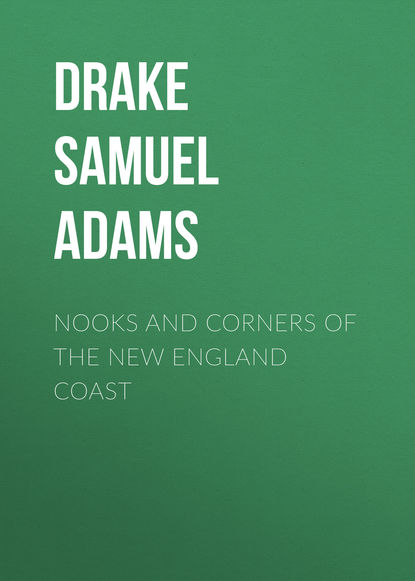
Полная версия
The Taking of Louisburg 1745

Samuel Adams Drake
The Taking of Louisburg 1745
I
COLONIAL SEACOAST DEFENCES
The creation of great maritime fortresses, primarily designed to hold with iron hand important highways of commerce, like Gibraltar, or simply to guard great naval arsenals, like Kronstadt, or, again, placed where some great river has cleft a broad path into the heart of a country, thus laying it open to invasion, has long formed part of the military policy of all maritime nations.
In the New World the Spaniards were the first to emphasize their adhesion to these essential principles by the erection of strongholds at Havana, Carthagena, Porto Bello, and Vera Cruz, not more to guarantee the integrity of their colonial possessions, than to protect themselves against the rapacity of the titled freebooters of Europe, to whom the treasure fleets of Mexico and the East offered a most alluring prey. When Spain carried the purse, all the crowned heads of Europe seem to have turned highwaymen.
With this single exception the seaboard defences of the Atlantic coast, even as late as the middle of the eighteenth century, were of the most trivial character, nor was it owing to any provision for defence that the chief ports of the English colonies enjoyed the long immunity they did. England left her colonies to stand or fall upon their own resources. Fortunate beyond expectation, they simply throve by neglect. France, with a widely different colonial policy, did a little better, but with a niggardly hand, while her system was squeezing the life-blood out of her colonists, drop by drop. Had there been a Drake or a Hawkins in the Spanish service, Spain might easily have revenged all past affronts by laying desolate every creek and harbor of the unprotected North Atlantic coast. She had the armed ports, as we have just shown. She had the ships and sailors. What, then, was to have prevented her from destroying the undefended villages of Charleston, Philadelphia, New York, and Boston?
Though she set about it so tardily, France was at length compelled to adopt a system of defence for Canada, or see Canada wrested from her control. In a most sweeping sense the St. Lawrence was the open gateway of Canada. There was absolutely no other means of access to all its vast territory except through the long, little known, and scarce-travelled course of the Mississippi – a route which, for many reasons besides its isolation, removed it from consideration as an avenue of attack.
Quebec was as truly the heart of Canada as the St. Lawrence was its great invigorating, life-giving artery. It is true that Quebec began to assume at a very early day something of its later character as half city, half fortress, but the views of its founders were unquestionably controlled as much by the fact of remoteness from the sea, as by Quebec’s remarkable natural capabilities for blocking the path to an enemy.
Yet even before the memorable and decisive battle on the Plains of Abraham, by which Canada was lost to France forever, the St. Lawrence had been thrice ascended by hostile fleets, and Quebec itself once taken by them. Mere remoteness was thus demonstrated to be no secure safeguard against an enterprising enemy. But what if that enemy should seize and fortify the mouth of the St. Lawrence itself? He would have put a tourniquet upon the great artery, to be tightened at his pleasure, and the heart of the colony, despite its invulnerable shield, would beat only at his dictation.
We will now pass on to the gradual development of this idea in the minds of those who held the destiny of Canada in their keeping.
II
LOUISBURG REVISITED
The annals of a celebrated fortress are sure to present some very curious and instructive phases of national policy and character. Of none of the fortresses of colonial America can this be said with greater truth than of Louisburg, once the key and stronghold of French power in Canada.
No historic survey can be called complete which does not include the scene itself. Nowhere does the reality of history come home to us with such force, or leave such deep, abiding impressions, as when we stand upon ground where some great action has been performed, or reach a spot hallowed by the golden memories of the past. It gives tone, color, consistency to the story as nothing else can, and, for the time being, we almost persuade ourselves that we, too, are actors in the great drama itself.
The Cape Breton Coast.
It is doubtless quite true that the first impressions one gets when coming into Louisburg from sea must be altogether disappointing. Indeed, speaking for myself, I had formed a vague notion, I know not how, that I was going to see another Quebec, or, at least, something quite like that antique stronghold, looming large in the distance, just as the history of the fortress itself looms up out of its epoch. On the contrary, we saw a low, tame coast, without either prominent landmark or seamark to denote the harbor, except to those who know every rock and tree upon it, lifting nowhere the castellated ruins that one’s eyes are strained to seek, and chiefly formidable now on account of the outlying shoals, sunken reefs, and intricate passages that render the navigation both difficult and dangerous to seamen.
Lighthouse Point.
On drawing in toward the harbor, we pass between a cluster of three small, rocky islets at the left hand, one of which is joined to that shore by a sunken reef; and a rocky point, of very moderate elevation, at the right, on which the harbor lighthouse stands, the ship channel being thus compressed to a width of half a mile between the innermost island and point.
The harbor is so spacious as to seem deserted, and so still as to seem oppressive.
Island Battery.
The island just indicated was, in the days of the Anglo-French struggles here, the key to this harbor, but the opposite point proved the master-key. Neither of the great war fleets that took part in the two sieges of Louisburg ventured to pass the formidable batteries of that island, commanding as they did the entrance at short range, and masking the city behind them, until their fire had first been silenced from the lighthouse point yonder. When that was done, Louisburg fell like the ripe pear in autumn.
Old Louisburg.
The old French city and fortress, the approach to which this Island Battery thus securely covered, rose at the southwest point of the harbor, or on the opposite to the present town of Louisburg, which is a fishing and coaling station for six months in the year, and for the other six counts for little or nothing. In summer it is land-locked; in winter, ice-locked. Pack ice frequently blockades the shores of the whole island until May, and snow sometimes lies in the woods until June. Yet in Cape Breton they call Louisburg an open harbor, and its choice as the site for a fortress finally turned upon the belief that it was accessible at all seasons of the year. As to that, we shall see later.
Face of the Country.
As for the country lying between Sydney and Louisburg, all travellers agree in pronouncing it wholly without interesting features. And the few inhabitants are scarcely more interesting than the country. In a word, it is roughly heaved about in a series of shaggy ridges, sometimes rising to a considerable height, through which the Mira, an arm of the sea, forces its way at flood-tide. There is a settlement or two upon this stream, as there was far back in the time of the French occupation, but everything about the country wears a forlorn and unprosperous look; the farms being few and far between, the houses poor, the land thin and cold, and the people – I mean them no disparagement – much like the land, from which they get just enough to live upon, and no more. Fortunately their wants are few, and their habits simple.
Remains of the Fortress.
Louisburg is certainly well worth going nine hundred miles to see, but when, at last, one stands on the grass-grown ramparts, and gets his first serious idea of their amazing strength and extent, curiosity is lost in wonder, wonder gives way to reflection, and reflection leads straight to the question, “What do all these miles of earthworks mean?” And I venture to make the assertion that no one who has ever been to Louisburg will rest satisfied till he has found his answer. The story is long, but one rises from its perusal with a clearer conception of the nature of the struggle for the mastery of a continent.
Perhaps the one striking thought about this place is its utter futility. Man having no further use for it, nature quietly reclaims it for her own again. Sheep now walk the ramparts instead of sentinels.
Dominating Hills.
Upon looking about him, one sees the marked feature of all this region in the chain of low hills rising behind Louisburg. But a little back from the coast the hills rise higher, are drawn more compactly together, and assume the semi-mountainous character common to the whole island.
Green Hill.
As this chain of hills undulates along the coast here, sometimes bending a little back from it, or again inclining out toward it, one of its zigzags approaches within a mile of Louisburg. At this point, several low, lumpy ridges push off for the seashore, through long reaches of boggy moorland, now and then disappearing beneath a shallow pond or stagnant pool, which lies glistening among the hollows between. Where it is uneven the land is stony and unfertile; where level, it is a bog. This rendered the land side as unfavorable to a besieging force as the nest of outlying rocks and reefs did the sea approaches. A continued rainfall must have made it wholly untenable for troops.
The Fortified Line.
It is one of these ridges just noticed as breaking away from the main range toward the seashore, and so naturally bent, also, as to touch the sea at one end and the harbor at the other, that the French engineers converted into a regular fortification; while within the space thus firmly enclosed by both nature and art, the old city of the lilies stretched down a gentle, grassy slope to the harbor shore.
Demolition of the City.
Not one stone of this city remains upon another to-day. After the second siege (1758) the English engineers were ordered to demolish it, and so far as present appearances go, never was an order more effectually carried out. All that one sees to-day, in room of it, is a poor fishing hamlet, straggling along the edge of the harbor, the dwellings being on one side, and the fish-houses and stages on the other side of the Sydney road, which suddenly contracts into a lane, and then comes to an end, along with the village itself, in a fisherman’s back-yard.
Not so, however, with the still massive earthworks, for the British engineers were only able, after many months’ labor, and with a liberal use of powder, to partly execute the work of demolition assigned them.
I spent several hours, at odd times, in wandering about these old ruins, and could not help being thankful that for once, at least, the destroying hand of man had been compelled to abandon its work to the rains and frosts of heaven.
Citadel or King’s Bastion.
Beginning with the citadel, in which the formalities of the surrender took place, I found it still quite well defined, although nothing now remains above ground except some old foundation walls to show where long ranges of stone buildings once stood. Here were the different military offices, the officers’ quarters and the chapel. The shattered bomb-proofs, however, were still distinguishable, though much choked up with débris, and their well-turned arches remain to show how firmly the solid masonry resisted the assaults of the engineers. In these damp holes the women, children, and non-combatants passed most of the forty-seven days of the siege. From this starting-point one may continue the walk along the ramparts, without once quitting them, for fully a mile, to the point where they touch the seashore among the inaccessible rocks and heaving surf of the ocean itself.
The Casemates.
These ramparts nowhere rise more than fifty feet above the sea-level, but are everywhere of amazing thickness and solidity. The moat was originally eighty feet across, and the walls stood thirty feet above it, but these dimensions have been much reduced by the work of time and weather. A considerable part of the line was further defended by a marsh, through which a storming column would have found it impossible to advance, and hardly less difficult to make a retreat. The besiegers were therefore obliged to concentrate their attack upon one or two points, and these had been rendered the most formidable of the whole line in consequence of the knowledge that the other parts were comparatively unassailable. In other words, the besieged were able to control, in a measure, where the besiegers should attack them.
Natural Obstacles made use of.
Although the partly ruined bomb-proofs are the only specimens of masonry now to be seen in making this tour, the broad and deep excavation of the moat and covered-way, and the clean, well-grassed slopes of the glacis, promise to hold together for another century at least. Brambles and fallen earth choke up the embrasures. It is necessary to use care in order to avoid treading upon a toad or a snake while you are groping among the mouldy casemates or when crossing the parade. Those magical words “In the King’s name,” so often proclaimed here with salvos of artillery, have now no echo except in the sullen dash of the sea against the rocky shores outside the perishing fortress, and
“What care these roarers for the name of King?”
Graveyard, Point Rochefort.
Still following the sheep-paths that zigzag about so as nearly to double the distance, I next turned back toward the harbor, leaving on my right the bleak and wind-swept field in which, to the lasting reproach of New England, five hundred of her bravest sons lie without stone or monument to mark their last resting-place. It is true that most of these men died of disease, and not in battle; yet to see the place as I saw it, in all its pitiful nakedness, isolation, and neglect, is the one thing at Louisburg that a New Englander would gladly have missed; and he will be very apt to walk on with a slower and less confident step, and with something less of admiration for the glory which consigns men to such oblivion as this.
Royal Battery.
To give anything like an adequate idea of how skilfully all the peculiarities of the ground were in some cases made use of in forming the defences, or in others, with equal art, overcome, would require a long chapter to itself. In order to render the main fortress more secure, the French engineer officers selected a spot three-fourths of a mile above it, on the harbor shore, on which they erected a battery that raked the open roadstead with its fire. It was a very strong factor in the system of defences as against a sea attack. This isolated work was called the Royal Battery, or in the English accounts, the Grand Battery. Yet, so far from contributing to the successful defence of the fortress, it became, in the hands of the besiegers, a powerful auxiliary to its capture. But the whole system of defence here shows that the marshes extending on the side of Gabarus Bay, where a landing was practicable only in calm weather, were considered an insuperable obstacle to the movements of artillery; and without artillery Louisburg could never have been seriously attacked from the land side. Against a sea attack it was virtually impregnable.
III
LOUISBURG TO SOLVE IMPORTANT POLITICAL AND MILITARY PROBLEMS
Having glanced at the purely military exigencies, which had at length forced themselves upon the attention of French statesmen, and having gone over the ground with the view of impressing its topographical features more firmly in our minds, we may now look at the underlying political and economic causes, out of which the French court finally matured a scheme for the maintenance of their colonial possessions in Canada in the broadest sense.
French Colonial System.
Its Unsatisfactory Workings.
In creating Louisburg the court of Versailles had far more extended views than the building of a strong fortress to guard the gateway into Canada would of itself imply. Unquestionably that was a powerful inducement to the undertaking; but, in the beginning, it certainly appears to have been only a secondary consideration. For a long time the condition of affairs in the colony had been far from satisfactory, while the future promised little that was encouraging. Compared with the English colonies, its progress was slow, irregular, and unstable. Agriculture was greatly neglected. So were manufactures. The home government had exercised, from the first, a guardianship that in the long run proved fatal to the growth of an independent spirit. There were swarms of governmental and ecclesiastical dependents who laid hold of the fattest perquisites, or else, through munificent and inconsiderate grants obtained from the crown, enjoyed monopolies of trade to the exclusion of legitimate competition. These leeches were sucking the life-blood out of Canada. So far, then, from being a self-sustaining colony, the annual disbursements of the crown were looked to as a means to make good the deficiency arising between what the country produced and what it consumed. Without protection the English colonies steadily advanced in wealth and population; with protection, Canada, settled at about the same time, scarcely held her own.
Two very able and sagacious men, the intendants Raudot, were the first who had the courage to lay before the court of Versailles the true condition of affairs, and the ability to suggest a remedy for it.
The Fur Trade Monopoly.
These intendants represented that the fur trade had always engrossed the attention of the Canadians, to the exclusion of everything else. Not only had the beaver skin become the recognized standard for all exchanges of values, but the estimated annual product of the country was based upon it, very much as we should reckon the worth of the grain crop to the United States to-day. It was also received in payment for revenues. Now, after a long experience, what was the result of an exclusive attention to this traffic? It was shown that the fur trade enriched no one except a few merchants, who left the country as soon as they had acquired the means of living at their ease in Old France. It had, therefore, no element whatever of permanent advantage to the colony.
Danger of Exclusive Attention to it.
It was also shown that this fur trade was by no means sufficient to sustain a colony of such importance as Canada unquestionably might become under a different system of management; for whether the beaver should finally become extinct through the greed of the traders, or so cheapened by glutting the market abroad as to lose its place in commerce entirely, it was evident that precisely the same result would be reached. In any case, the business was a precarious one. It limited the number of persons who could be profitably employed; it bred them up to habits of indolence and vice without care for the future; and it kept them in ignorance and poverty to the last. But, what was worst of all, this all-engrossing pursuit kept the population from cultivating the soil, the true and only source of prosperity to any country.
Other cogent reasons were given, but these most conclusively set forth what a mercantile monopoly having its silent partners in the local government and church, as well as in the royal palace itself, had been able to do in the way of retarding the development of the great native resources of Canada. It was so ably done that no voice was raised against it. And with this most lucid and fearless exposé of the puerile use thus far made of those resources the memorialist statesmen hoped to open the king’s eyes.
The two Raudots offer a Remedy.
They now proposed to wholly reorganize this unsound commercial system by directing capital and labor into new channels. Such natural productions of the country as masts, boards, ship-timber, flax, hemp, plaster, iron and copper ores, dried fish, whale and seal oils, and salted meats, might be exported, they said, with profit to the merchant and advantage to the laboring class, provided a suitable port were secured, at once safe, commodious, and well situated for collecting all these commodities, and shipping them abroad.
Cape Breton brought to Notice.
To this end, these intendants now first brought to notice the advantages of Cape Breton for such an establishment. Strangely enough, up to this time little or no attention had been paid to this island. Three or four insignificant fishing ports existed on its coasts, but as yet the whole interior was a shaggy wilderness, through which the Micmac Indians roamed as freely as their fathers had done before Cartier ascended the St. Lawrence. Its valuable deposits of coal and gypsum lay almost untouched in their native beds; its stately timber trees rotted where they grew; its unrivalled water-ways, extending through the heart of the island, served no better purpose than as a highway for wandering savages.
Acadia to be helped.
By creating such a port as the Raudots suggested, the voyage from France would be shortened one half, and the dangerous navigation of the St. Lawrence altogether avoided, since, instead of large ships having to continue their voyages to Quebec, the carrying trade of the St. Lawrence would fall to coasting vessels owned in the colony. A strong hand would also be given to the neighbor province, the fertile yet unprotected Acadia, which might thus be preserved against the designs of the English, while a thriving trade in wines, brandies, linens, and rich stuffs might reasonably be expected to spring up with the neighboring English colonies.
A Military and Naval Arsenal proposed.
These were considerations of such high national importance as to at once secure for the project an attention which purely strategic views could hardly be expected to command. And yet, the forming of a military and naval depot, strong enough to guarantee the security of the proposed port, and in which the king’s ships might at need refit, or take refuge, or sally out upon an enemy, was an essential feature of this elaborate plan, every detail of which was set forth with systematic exactness. For seven years the project was pressed upon the French court. War, however, then engaging the whole attention of the ministry, the execution of this far-seeing project, which had in view the demands of peace no less than of war, was unavoidably put off until the peace of Utrecht, in 1713, by giving a wholly new face to affairs in the New World, compelled France to take energetic measures for the security of her colonial possessions.
Peace of Utrecht.
By this treaty of Utrecht France surrendered to England all Nova Scotia, all her conquests in Hudson’s Bay, with Placentia, her most important establishment in Newfoundland. At the same time the treaty left Cape Breton to France, an act of incomparable folly on the part of the English plenipotentiaries who, with the map lying open before them, thus handed over to Louis the key of the St. Lawrence and of Canada. No one now doubts that the French king saw in this masterpiece of stupidity a way to retrieve all he had lost at a single stroke. The English commissioners, it is to be presumed, saw nothing.
English Harbor chosen.
Having the right to fortify, under the treaty, it only remained for the French court to determine which of the island ports would be best adapted to the purpose, St. Anne, on the north, or English Harbor on the south-east coast. St. Anne was a safe and excellent haven, easily made impregnable, with all the materials requisite for building and fortifying to be found near the spot. Behind it lay the fertile côtes of the beautiful Bras d’Or, with open water stretching nearly to the Straits of Canso. On the other hand, besides being surrounded by a sterile country, materials of every kind, except timber, must be transported to English Harbor at a great increase of labor and cost. More could be done at St. Anne with two thousand francs, it was said, than with two hundred thousand at the rival port. But the difficulty of taking ships of large tonnage into St. Anne through an entrance so narrow that only one could pass in or out at the same time, finally gave the preference to English Harbor, which had a ship channel of something less than two hundred fathoms in breadth, a good anchorage, and plenty of beach room for erecting stages and drying fish. It was, moreover, sooner clear of ice in spring.










